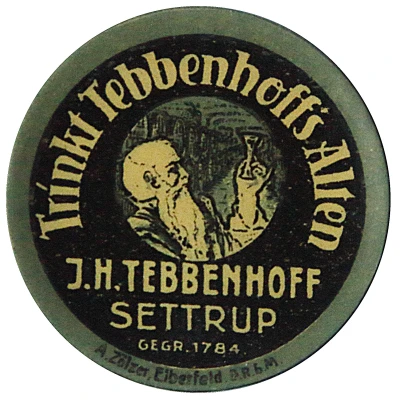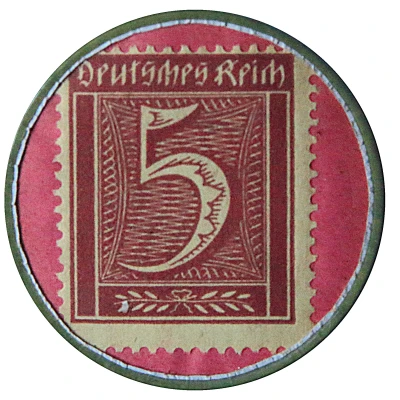


© R.J. Adams
5 Pfennigs - Settrup Tebbenhoff ND
1921 year| Cardboard | 0.5 g | 32.55 mm |
| Issuer | Village of Settrup (Prussian province of Hanover) |
|---|---|
| Period | Weimar Republic (1918-1933) |
| Type | Standard circulation coin |
| Year | 1921 |
| Value | 5 Pfennigs (5 Pfennige) (0.05) |
| Currency | Mark (1914-1924) |
| Composition | Cardboard |
| Weight | 0.5 g |
| Diameter | 32.55 mm |
| Thickness | 0.75 mm |
| Shape | Round |
| Orientation | Medal alignment ↑↑ |
| Demonetized | Yes |
| Updated | 2024-10-04 |
| Numista | N#151905 |
|---|---|
| Rarity index | 89% |
Reverse
Five cent Deutsches Reich stamp encased in cellophane on a red paper background.
Lettering:
Deutsches Reich
5
Comment
This style of notgeld is known as "Briefmarkenkapselgeld" or "encased postage" and was used by some businesses as substitute for government authorized coinage during periods on monetary scarcity. While the coin is undated, the stamps used in both this piece and the 10 Pfenning Briefmarkenkapselgeld were only issued in 1921.Menzel: DDD
Interesting fact
One interesting fact about the 5 Pfennigs - Settrup (Tebbenhoff) ND (1921) coin is that it was made of cardboard, which is a unique and unusual material for coins. Most coins are made of metals like copper, silver, or gold, but this coin was created during a time of economic hardship and hyperinflation in Germany, when traditional metallic coins were not feasible. The use of cardboard as a material for coins was a temporary solution to address the shortage of metal coins, and it is a distinctive feature of this particular coin.